09年考研英语阅读题及答案
- 格式:doc
- 大小:23.00 KB
- 文档页数:2
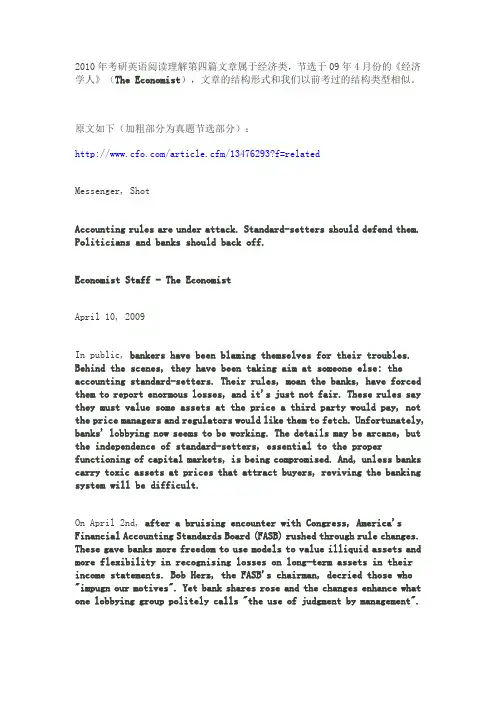
2010年考研英语阅读理解第四篇文章属于经济类,节选于09年4月份的《经济学人》(The Economist),文章的结构形式和我们以前考过的结构类型相似。
原文如下(加粗部分为真题节选部分):/article.cfm/13476293?f=relatedMessenger, ShotAccounting rules are under attack. Standard-setters should defend them. Politicians and banks should back off.Economist Staff - The EconomistApril 10, 2009In public, bankers have been blaming themselves for their troubles. Behind the scenes, they have been taking aim at someone else: the accounting standard-setters. Their rules, moan the banks, have forced them to report enormous losses, and it's just not fair. These rules say they must value some assets at the price a third party would pay, not the price managers and regulators would like them to fetch. Unfortunately, banks' lobbying now seems to be working. The details may be arcane, but the independence of standard-setters, essential to the proper functioning of capital markets, is being compromised. And, unless banks carry toxic assets at prices that attract buyers, reviving the banking system will be difficult.On April 2nd, after a bruising encounter with Congress, America's Financial Accounting Standards Board (FASB) rushed through rule changes. These gave banks more freedom to use models to value illiquid assets and more flexibility in recognising losses on long-term assets in their income statements. Bob Herz, the FASB's chairman, decried those who "impugn our motives". Yet bank shares rose and the changes enhance what one lobbying group politely calls "the use of judgment by management".European ministers instantly demanded that the International Accounting Standards Board (IASB) do likewise. The IASB says it does not want to be "piecemeal", but the pressure to fold when it completes its overhaul of rules later this year is strong. On April 1st Charlie McCreevy, a European commissioner, warned the IASB that it did "not live in a political vacuum" but "in the real world" and that Europe could yet develop different rules.It was banks that were on the wrong planet, with accounts that vastly overvalued assets. Today they argue that market prices overstate losses, because they largely reflect the temporary illiquidity of markets, not the likely extent of bad debts. The truth will not be known for years. But banks' shares trade below their book value, suggesting that investors are sceptical. And dead markets partly reflect the paralysis of banks which will not sell assets for fear of booking losses, yet are reluctant to buy all those supposed bargains.To get the system working again, losses must be recognised and dealt with. Japan's procrastination prolonged its crisis. America's new plan to buy up toxic assets will not work unless banks mark assets to levels which buyers find attractive. Successful markets require independent and even combative standard-setters. The FASB and IASB have been exactly that, cleaning up rules on stock options and pensions, for example, against hostility from special interests. But by appeasing critics now they are inviting pressure to make more concessions.To reveal, but not to regulateStandard-setters should defuse the argument by making clear that their job is not to regulate banks but to force them to reveal information. The banks, their capital-adequacy regulators and politicians seem to dream of a single, grown-up version of the truth, which enhances financial stability. Investors and accountants, however, think all valuations are subjective, doubt managers' motives and judge that market prices are the least-bad option. They are right. A bank's solvency is a matter of judgment for its regulators and for investors, not whatever a piece of paper signed by its auditors says it is. Accounts can inform that decision, but not make it.Banks' regulators have to take responsibility. If they want to remove the mechanical link between drops in market prices and capital shortfalls at banks, they should take the accounts that standard-setters create for investors and adjust them when they calculate capital. They already dothis to some degree. But the banks' campaign to change the rules is making inevitable a split between two sets of accounts, one for regulators and another for investors. The FASB and IASB can help regulators to create whatever balance-sheet they want. But in doing so they must not compromise their duty to investors.。
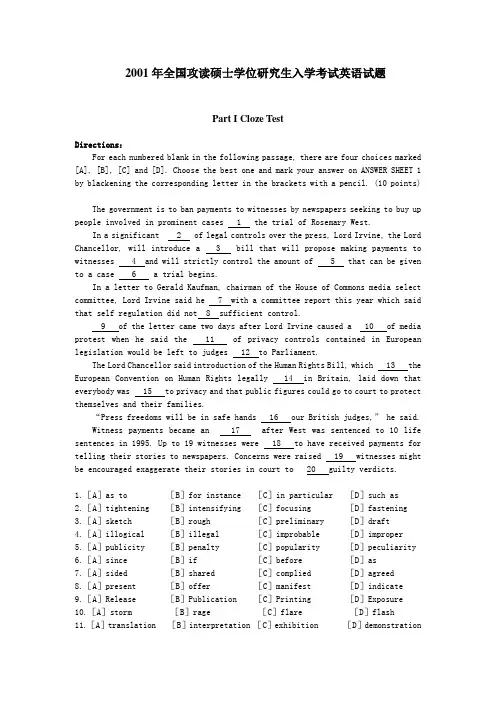
2001年全国攻读硕士学位研究生入学考试英语试题Part I Cloze TestDirections:For each numbered blank in the following passage, there are four choices marked [A], [B], [C] and [D]. Choose the best one and mark your answer on ANSWER SHEET 1 by blackening the corresponding letter in the brackets with a pencil. (10 points)The government is to ban payments to witnesses by newspapers seeking to buy up people involved in prominent cases 1 the trial of Rosemary West.In a significant 2 of legal controls over the press, Lord Irvine, the Lord Chancellor, will introduce a 3 bill that will propose making payments to witnesses 4 and will strictly control the amount of 5 that can be given to a case 6 a trial begins.In a letter to Gerald Kaufman, chairman of the House of Commons media select committee, Lord Irvine said he 7 with a committee report this year which said that self regulation did not 8 sufficient control.9 of the letter came two days after Lord Irvine caused a 10 of media protest when he said the 11 of privacy controls contained in European legislation would be left to judges 12 to Parliament.The Lord Chancellor said introduction of the Human Rights Bill, which 13 the European Convention on Human Rights legally 14 in Britain, laid down that everybody was 15 to privacy and that public figures could go to court to protect themselves and their families.“Press freedoms will be in safe hands 16 our British judges,” he said.Witness payments became an 17 after West was sentenced to 10 life sentences in 1995. Up to 19 witnesses were 18 to have received payments for telling their stories to newspapers. Concerns were raised 19 witnesses might be encouraged exaggerate their stories in court to 20 guilty verdicts.1.[A]as to [B]for instance [C]in particular [D]such as2.[A]tightening [B]intensifying [C]focusing [D]fastening3.[A]sketch [B]rough [C]preliminary [D]draft4.[A]illogical [B]illegal [C]improbable [D]improper5.[A]publicity [B]penalty [C]popularity [D]peculiarity6.[A]since [B]if [C]before [D]as7.[A]sided [B]shared [C]complied [D]agreed8.[A]present [B]offer [C]manifest [D]indicate9.[A]Release [B]Publication [C]Printing [D]Exposure10.[A]storm [B]rage [C]flare [D]flash11.[A]translation [B]interpretation [C]exhibition [D]demonstration12.[A]better than [B]other than [C]rather than [D]sooner than13.[A]changes [B]makes [C]sets [D]turns14.[A]binding [B]convincing [C]restraining [D]sustaining15.[A]authorized [B]credited [C]entitled [D]qualified16.[A]with [B]to [C]from [D]by17.[A]impact [B]incident [C]inference [D]issue18.[A]stated [B]remarked [C]said [D]told19.[A]what [B]when [C]which [D]that20.[A]assure [B]confide [C]ensure [D]guaranteePart II Reading ComprehensionDirections:Each of the passages below is followed by some questions. For each questions there are four answers marked [A], [B], [C] and [D]. Read the passages carefully and choose the best answer to each of the questions. Then mark your answer on ANSWER SHEET 1 by blackening the corresponding letter in the brackets with a pencil. (40 points)Passage 1Specialisation can be seen as a response to the problem of an increasing accumulation of scientific knowledge. By splitting up the subject matter into smaller units,one man could continue to handle the information and use it as the basis for further research. But specialisation was only one of a series of related developments in science affecting the process of communication. Another was the growing professionalisation of scientific activity.No clear-cut distinction can be drawn between professionals and amateurs in science: exceptions can be found to any rule. Nevertheless, the word “amateur”does carry a connotation that the person concerned is not fully integrated into the scientific community and, in particular, may not fully share its values. The growth of specialisation in the nineteenth century, with its consequent requirement of a longer, more complex training, implied greater problems for amateur participation in science. The trend was naturally most obvious in those areas of science based especially on a mathematical or laboratory training, and can be illustrated in terms of the development of geology in the United Kingdom.A comparison of British geological publications over the last century and a half reveals not simply an increasing emphasis on the primacy of research, but also a changing definition of what constitutes an acceptable research paper. Thus, in the nineteenth century, local geological studies represented worthwhile research in their own right; but, in the twentieth century, local studies have increasingly become acceptable to professionals only if they incorporate, and reflect on, the wider geological picture. Amateurs, on the other hand, have continued to pursue local studies in the old way. The overall result has been to make entrance to professionalgeological journals harder for amateurs, a result that has been reinforced by the widespread introduction of refereeing, first by national journals in the nineteenth century and then by several local geological journals in the twentieth century. As a logical consequence of this development, separate journals have now appeared aimed mainly towards either professional or amateur readership. A rather similar process of differentiation has led to professional geologists coming together nationally within one or two specific societies, whereas the amateurs have tended either to remain in local societies or to come together nationally in a different way.Although the process of professionalisation and specialisation was already well under way in British geology during the nineteenth century, its full consequences were thus delayed until the twentieth century. In science generally, however, the nineteenth century must be reckoned as the crucial period for this change in the structure of science.21. The growth of specialisation in the 19th century might be more clearly seen insciences such as _______.[AJ sociology and chemistry [B] physics and psychology[C] sociology and psychology [D] physics and chemistry22. We can infer from the passage that _______.[A] there is little distinction between specialisation and professionalisation[B] amateurs can compete with professionals in some areas of science[C] professionals tend to welcome amateurs into the scientific community[D] amateurs have national academic societies but no local ones23. The author writes of the development of geology to demonstrate ______.[A] the process of specialisation and professionalisation[B] the hardship of amateurs in scientific study[C] the change of policies in scientific publications[D] the discrimination of professionals against amateurs24. The direct reason for specialisation is _______.[A] the development in communication[B] the growth of professionalisation[C] the expansion of scientific knowledge[D] the splitting up of academic societiesPassage 2A great deal of attention is being paid today to the so-called digital divide-the division of the world into the info (information) rich and the info poor. And that divide does exist today. My wife and I lectured about this looming danger twenty years ago. What was less visible then, however, were the new, positive forces that work against the digital divide. There are reasons to be optimistic.There are technological reasons to hope the digital divide will narrow. As the Internet becomes more and more commercialized, it is in the interest of businessto universalize access-after all, the more people online, the more potential customers there are. More and more governments, afraid their countries will be left behind, want to spread Internet access. Within the next decade or two, one to two billion people on the planet will he netted together. As a result, I now believe the digital divide will narrow rather than widen in the years ahead. And that is very good news because the Internet may well be the most powerful tool for combating world poverty that we’ve ever had.Of course, the use of the Internet isn’t the only way to defeat poverty. And the Internet is not the only tool we have. But it has enormous potential.To take advantage of this tool, some impoverished countries will have to get over their outdated anti-colonial prejudices with respect to foreign investment. Countries that still think foreign investment is an invasion of their sovereignty might well study the history of infrastructure(the basic structural foundations of a society)in the United States. When the United States built its industrial infrastructure, it didn’t have the capital to do so. And that is why America’s Second Wave infrastructure-including roads, harbors, highways, ports and so on-were built with foreign investment. The English, the Germans, the Dutch and the French were investing in Britain’s former colony. They financed them. Immigrant Americans built them. Guess who owns them now? The Americans. I believe the same thing would be true in places like Brazil or anywhere else for that matter. The more foreign capital you have helping you build your Third Wave infrastructure, which today is an electronic infrastructure, the better off you’re going to be. That doesn't mean lying down and becoming fooled, or letting foreign corporations run uncontrolled. But it does mean recognizing how important they can be in building the energy and telecom infrastructures needed to take full advantage of the Internet.25. Digital divide is something _______.[A] getting worse because of the Internet[B] the rich countries are responsible for[C] the world must guard against[D] considered positive today26. Governments attach importance to the Internet because it _______.[A] offers economic potentials[B] can bring foreign funds[C] can soon wipe out world poverty[D] connects people all over the world27. The writer mentioned the case of the United States to justify the policy of_______.[A] providing financial support overseas[B] preventing foreign capital’s control[C] building industrial infrastructure[D] accepting foreign investment28. It seems that now a country’s economy depands much on ______.[A] how well-developed it is electronically[B] whether it is prejudiced against immigrants[C] whether it adopts America’s industrial pattern[D] how much control it has over foreign corporationsPassage 3Why do so many Americans distrust what they read in their newspapers? The American Society of Newspaper Editors is trying to answer this painful question. The organization is deep into a long self-analysis known as the journalism credibility project.Sad to say, this project has turned out to be mostly low-level findings about factual errors and spelling and grammar mistakes, combined with lots of headscratching puzzlement about what in the world those readers really want.But the sources of distrust go way deeper. Most journalists learn to see the world through a set of standard templates (patterns) into which they plug each day’s events. In other words, there is a conventional story line in the newsroom culture that provides a backbone and a ready-made narrative structure for otherwise confusions news.There exists a social and cultural disconnect between journalists and their readers which helps explain why the “standard templates”of the newsroom seem alien many readers. In a recent survey, questionnaires were sent to reporters in five middle size cities around the country, plus one large metropolitan area. Then residents in these communities were phoned at random and asked the same questions.Replies show that compared with other Americans, journalists are more likely to live in upscale neighborhoods, have maids, own Mercedeses, and trade stocks, and they’re less likely to go to church, do volunteer work, or put down roots in community.Reporters tend to be part of a broadly defined social and cultural elite, so their work tends to reflect the conventional values of this elite. The astonishing distrust of the news media isn’t rooted in inaccuracy or poor reportorial skills but in the daily clash of world views between reporters and their readers.This is an explosive situation for any industry, particularly a declining one. Here is a troubled business that keeps hiring employees whose attitudes vastly annoy the customers. Then it sponsors lots of symposiums and a credibility project dedicated to wondering why customers are annoyed and fleeing in large numbers. But it never seems to get around to noticing the cultural and class biases that so many former buyers are complaining about. If it did, it would open up its diversity program, now focused narrowly on race and gender, and look for reporters who differ broadly by outlook, values, education, and class.29. What is the passage mainly about?[A] needs of the readers all over the world.[B] causes of the public disappointment about newspapers.[C] origins of the declining newspaper industry.[D] aims of a journalism credibility project.30. The results of the journalism credibility project turned out to be ______.[A] quite trustworthy [B] somewhat contradictory[C] very illuminating [D] rather superficial31. The basic problem of journalists as pointed out by the writer lies in their______.[A] working attitude [B] conventional lifestyle[C] world outlook [D] educational background32. Despite its efforts, the newspaper industry still cannot satisfy the readersowing to its_______.[A] failure to realize its real problem[B] tendency to hire annoying reporters[C] likeliness to do inaccurate reporting[D] prejudice in matters of race and genderPassage 4The world is going through the biggest wave of mergers and acquisitions ever witnessed. The process sweeps from hyperactive America to Europe and reaches the emerging countries with unsurpassed might. Many in these countries are looking at this process and worrying: "Won't the wave of business concentration turn into an uncontrollable anti-competitive force?"There's no question that the big are getting bigger and more powerful. Multinational corporations accounted for less than 20% of international trade in 1982. Today the figure is more than 25% and growing rapidly. International affiliates account for a fast-growing segment of production in economies that open up and welcome foreign investment. In Argentina, for instance, after the reforms of the early 1990s, multinationals went from 43% to almost 70% of the industrial production of the 200 largest firms. This phenomenon has created serious concerns over the role of smaller economic firms, of national businessmen and over the ultimate stability of the world economy.I believe that the most important forces behind the massive M&A wave are the same that underlie the globalization process: falling transportation and communication costs, lower trade and investment barriers and enlarged markets that require enlarged operations capable of meeting customers' demands. All these are beneficial, not detrimental, to consumers. As productivity grows, the world's wealth increases.Examples of benefits or costs of the current concentration wave are scanty. Yet it is hard to imagine that the merger of a few oil firms today could re-create the same threats to competition that were feared nearly a century ago in the U.S., when the Standard Oil trust was broken up. The mergers of telecom companies, such as WorldCom, hardly seem to bring higher prices for consumers or a reduction in thepace of technical progress. On the contrary, the price of communications is coming down fast. In cars, too, concentration is increasing-witness Daimler and Chrysler, Renault and Nissan-but it does not appear that consumers are being hurt.Yet the fact remains that the merger movement must be watched. A few weeks ago, Alan Greenspan warned against the megamergers in the banking industry. Who is going to supervise, regulate and operate as lender of last resort with the gigantic banks that are being created? Won't multinationals shift production from one place to another when a nation gets too strict about infringements to fair competition? And should one country take upon itself the role of “defending competition”on issues that affect many other nations, as in the U S. vs. Microsoft case ?33. What is the typical trend of businesses today?[A] to take in more foreign funds. [B] to invest more abroad.[C] to combine and become bigger. [D] to trade with more countries.34. According to the author, one of the driving forces behind M&A wave is ______[A] the greater customer demands. [B] a surplus supply for the market.[C] a growing productivity. [D] the increase of the world's wealth.35. From paragraph 4 we can infer that ______.[A] the increasing concentration is certain to hurt consumers[B] WorldCom serves as a good example of both benefits and costs[C] the costs of the globalization process are enormous[D] the Standard Oil trust might have threatened competition36. Toward the new business wave, the writer's attitude can he said to be _______.[A] optimistic [B] objective[C] pessimistic [D] biasedPassage 5When I decided to quit my full time employment it never occurred to me that I might become a part of a new international trend. A lateral move that hurt my pride and blocked my professional progress prompted me to abandon my relatively high pro although, in the manner of a disgraced government minister, I covered my exit by claiming “I wanted to spend more time with my family”.Curiously, some two-and-a-half years and two novels later, my experiment in what the Americans term “downshifting”has turned my tired excuse into an absolute reality. I have been transformed from a passionate advocate of the philosophy of “having it all”, preached by Linda Kelsey for the past seven years in the pages of She magazine, into a woman who is happy to settle for a bit of everything.I have discovered, as perhaps Kelsey will after her much-publicized resignation from the editorship of She after a build-up of stress, that abandoning the doctrine of “juggling your life”, and making the alternative move into “downshifting”brings with it far greater rewards than financial success and social status. Nothing could persuade me to return to the kind of life Kelsey used to advocate and I onceenjoyed: 12-hour working days, pressured deadlines, the fearful strain of office politics and the limitations of being a parent on “quality time”.In America, the move away from juggling to a simpler, less materialistic lifestyle is a well-established trend. Downshifting-also known in America as “voluntary simplicity” has, ironically, even bred a new area of what might be termed anticonsumerism. There are a number of bestselling downshifting self-help books for people who want to simplify their lives; there are newsletter's, such as The Tightwad Gazette, that give hundreds of thousands of Americans useful tips on anything from recycling their cling-film to making their own soap; there are even support groups for those who want to achieve the mid- '90s equivalent of dropping out.While in America the trend started as a reaction to the economic decline——after the mass redundancies caused by downsizing in the late’80s——and is still linked to the politics of thrift, in Britain, at least among the middle-class downshifters of my acquaintance, we have different reasons for seeking to simplify our lives.For the women of my generation who were urged to keep juggling through the’80s, downshifting in the mid-'90s is not so much a search for the mythical good life ——growing your own organic vegetables, and risking turning into one——as a personal recognition of your limitations.37. Which of the following is true according to paragraph 1?[A] Full-time employment is a new international trend.[B] The writer was compelled by circumstances to leave her job.[C] “A lateral move” means stepping out of full-time employment.[D] The writer was only too eager to spend more time with her family.38. The writer’s experiment shows that downshifting ____[A] enables her to realize her dream[B] helps her mold a new philosophy of life[C] prompts her to abandon her high social status[D] leads her to accept the doctrine of She magazine39. “Juggling one’s life” probably means living a life characterized by_____.[A] non-materialistic lifestyle [B] a bit of everything[C] extreme stress [D] anti-consumerism40. According to the passage, downshifting emerged in the U.S. as a result of _____[A] the quick pace of modern life [B] man’s adventurous spirit[C] man’s search for mythical experiences [D] the economic situationPart III English-Chinese TranslationDirections:Read the following text carefully and then translate the underlined segments intoChinese. Your translation should be written clearly on ANSWER SHEET 2. (15 points)In less than 30 years’ time the Star Trek holodeck will be a reality. Direct links between the brain’s nervous system and a computer will also create full sensory virtual environments, allowing virtual vacations like those in the film Total Recall.41)There will be television chat shows hosted by robots, and cars with pollution monitors that will disable them when they offend. 42)Children will play with dolls equipped with personality chips, computers with in-built personalities will be regarded as workmates rather than tools, relaxation will be in front of smell television, and digital age will have arrived.According to BT’s futurologist, Ian Pearson, these are among the developments scheduled for the first few decades of the new millennium(a period of 1,000 years), when supercomputers will dramatically accelerate progress in all areas of life.43)Pearson has pieced together the work of hundreds of researchers around the world to produce a unique millennium technology calendar that gives the latest dates when we can expect hundreds of key breakthroughs and discoveries to take place. Some of the biggest developments will be in medicine, including an extended life expectancy and dozens of artificial organs coming into use between now and 2040.Pearson also predicts a breakthrough in computer-human links. “By linking directly to our nervous system, computers could pick up what we feel and, hopefully, simulate feeling too so that we can start to develop full sensory environments, rather like the holidays in Total Recall or the Star Trek holodeck, ” he says. 44)But that, Pearson points out, is only the start of man-machine integration: “It will be the beginning of the long process of integration that will ultimately lead to a fully electronic human before the end of the next century.”Through his research, Pearson is able to put dates to most of the breakthroughs that can be predicted. However, there are still no forecasts for when faster-than-light travel will be available, or when human cloning will be perfected, or when time travel will be possible. But he does expect social problems as a result of technological advances. A boom in neighborhood surveillance cameras will, for example, cause problems in 2010, while the arrival of synthetic lifelike robots will mean people may not be able to distinguish between their human friends and the droids. 45)And home appliances will also become so smart that controlling and operating them will result in the breakout of a new psychological disorder—kitchen rage.Section V Writing46. Directions:Among all the worthy feelings of mankind, love is probably the noblest, but everyone has his/her own understanding of it.There has been a discussion recently on the issue in a newspaper. Write an essay to the newspaper to1)show your understanding of the symbolic meaning of the picture below.2)give a specific example, and3)give your suggestion as to the best way to show love.第一部分英语知识应运试题解析一、文章总体分析本文是一篇报道性的文章,介绍了自露丝玛莉·韦斯特案件发生后,政府、法院、媒体各方面对于付款给证人的反应。
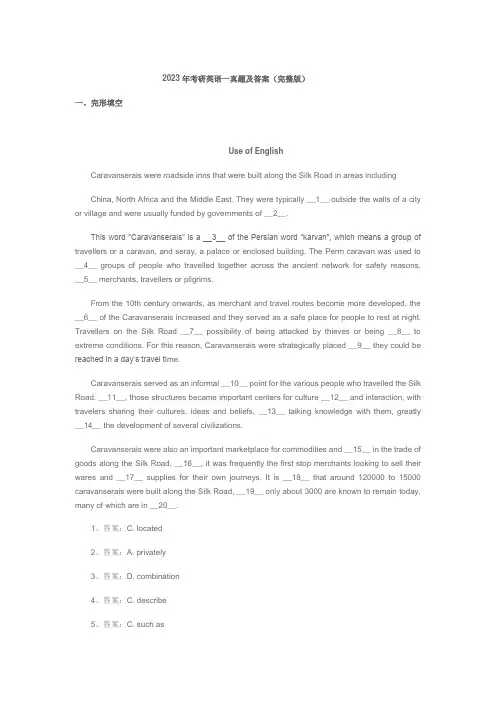
2023年考研英语一真题及答案(完整版)一、完形填空Use of EnglishCaravanserais were roadside inns that were built along the Silk Road in areas includingChina, North Africa and the Middle East. They were typically __1__ outside the walls of a city or village and were usually funded by governments of __2__.This word “Caravanserais” is a __3__ of the Persian word “karvan”, which means a group of travellers or a caravan, and seray, a palace or enclosed building. The Perm caravan was used to __4__ groups of people who travelled together across the ancient network for safety reasons, __5__ merchants, travellers or pilgrims.From the 10th century onwards, as merchant and travel routes become more developed, the __6__ of the Caravanserais increased and they served as a safe place for people to rest at night. Travellers on the Silk Road __7__ possibility of being attacked by thieves or being __8__ to extreme conditions. For this reason, Caravanserais were strategically placed __9__ they could be reached in a day’s travel ti me.Caravanserais served as an informal __10__ point for the various people who travelled the Silk Road. __11__, those structures became important centers for culture __12__ and interaction, with travelers sharing their cultures, ideas and beliefs, __13__ talking knowledge with them, greatly __14__ the development of several civilizations.Caravanserais were also an important marketplace for commodities and __15__ in the trade of goods along the Silk Road. __16__, it was frequently the first stop merchants looking to sell their wares and __17__ supplies for their own journeys. It is __18__ that around 120000 to 15000 caravanserais were built along the Silk Road, __19__ only about 3000 are known to remain today, many of which are in __20__.1、答案:C. located2、答案:A. privately3、答案:D. combination4、答案:C. describe5、答案:C. such as。

人行,中行,工行,建行,农行,交行笔试资料合集(坚决保留)来源:沈峰的日志中国银行去年校园招聘笔试的时间安排,仅供参考14:00~15:30英语16:00~17:00认知能力17:05~18:05综合知识【中国银行笔试通用资料:】一:中行英语笔试中行英语笔试总题量:20道单词选择,10道挑错,20道完型,四篇常规阅读(每篇5题),1篇文章排序,1篇句子填空,2篇快速阅读。
解题方法:单选、改错、完形、要快,把握在30-40秒一题,完形可拉到50秒吧(不是20题全部喔)然后先做快阅,锁定Key Word很快做到细节题,后一篇最后一问是理解题,要看完最后几段,否则会不会全部不要超过3分钟;普通阅读:4篇每篇5题先做细节题,找Key Word,概括理解可用排除法有些内容其实可以用一般常识来排除的先做1 2篇,然后撞(先涂卡)(ABCD随便)3 4篇,看完排序再返回做3 4篇排序:1)7段话,A-G,AG分别为头尾(已给出),排序B-FHowever开头的有G段和F段,明显F不接G,记得D C 内含some和other的对应关系2)一篇挖空5句,给8句选5并对应填,太难,没时间研究,撞顺序:总括:做完普阅12后吧34全部撞涂,做完排序再返回34,时间仍够,排序1应该思考做,2大可撞(实在太复杂)复习资料:2008.12.21中国银行笔试英语原题(强烈推荐啊):88/thread-95445-1-1.html银行考试英语:88/thread-90073-1-1.html你还可以去我们的求职英语版去看看::88/forum-441-1.html建议:去年的题目是很难,今年是否还是很难,我们都不清楚。
建议大家可以看看六级和考研的英语资料。
二:中行认知能力+(三)综合知识这两部分是连在一起的,一本试题册,但是分开计时,大家注意不要连着一口气做下去了。
认知能力:60分钟,满分150分以前是行测,但今年改成认知能力了,其实就是智商测试。
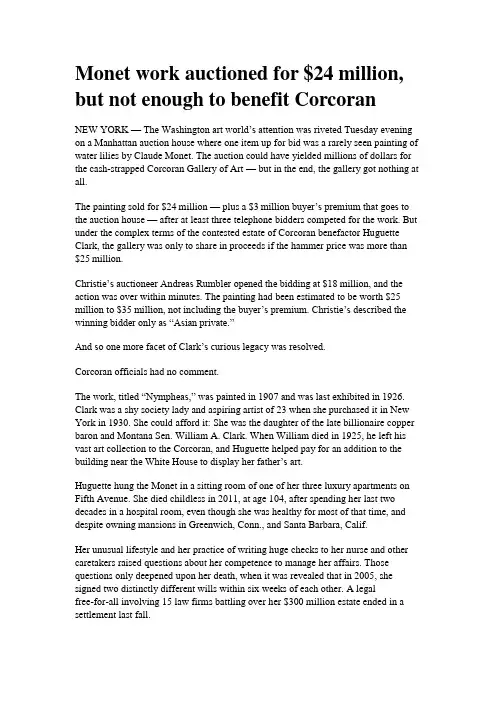
Monet work auctioned for $24 million, but not enough to benefit CorcoranNEW YORK —The Washington art world’s attention was riveted Tuesday evening on a Manhattan auction house where one item up for bid was a rarely seen painting of water lilies by Claude Monet. The auction could have yielded millions of dollars for the cash-strapped Corcoran Gallery of Art — but in the end, the gallery got nothing at all.The painting sold for $24 million — plus a $3 million buyer’s premium that goes to the auction house — after at least three telephone bidders competed for the work. But under the complex terms of the contested estate of Corcoran benefactor Huguette Clark, the gallery was only to share in proceeds if the hammer price was more than $25 million.Christie’s auctioneer Andreas Rumbler opened the bidding at $18 million, and the action was over within minutes. The painting had been estimated to be worth $25 million to $35 million, not including the buyer’s premium. Christie’s described the winning bidder only as “Asian private.”And so one more facet of Clark’s curious legacy was resolved.Corcoran officials had no comment.The work, titled “Nympheas,” was painted in 1907 and was last exhibited in 1926. Clark was a shy society lady and aspiring artist of 23 when she purchased it in New York in 1930. She could afford it: She was the daughter of the late billionaire copper baron and Montana Sen. William A. Clark. When William died in 1925, he left his vast art collection to the Corcoran, and Huguette helped pay for an addition to the building near the White House to display her father’s art.Huguette hung the Monet in a sitting room of one of her three luxury apartments on Fifth Avenue. She died childless in 2011, at age 104, after spending her last two decades in a hospital room, even though she was healthy for most of that time, and despite owning mansions in Greenwich, Conn., and Santa Barbara, Calif.Her unusual lifestyle and her practice of writing huge checks to her nurse and other caretakers raised questions about her competence to manage her affairs. Those questions only deepened upon her death, when it was revealed that in 2005, she signed two distinctly different wills within six weeks of each other. A legalfree-for-all involving 15 law firms battling over her $300 million estate ended in a settlement last fall.Which brings us to a vast gallery filled with more than 600 paddle-wielding art shoppers at Christie’s Rockefeller Center. The painting hung on the wall behind a bank of telephone operators who were taking bids from around the world. The Corcoran would have received half the proceeds from the sale of the Monet had it been in excess of $25 million.Separately, the Corcoran has been awarded $11.25 million in the settlement.The auction comes amid a dramatic transition for the Corcoran. Gallery executives are trying to finalize documents to enact the recently announced arrangement that would turn over responsibility for the historic Beaux-Arts building and the Corcoran College of Art & Design to George Washington University. The National Gallery of Art, meanwhile, would be given much of the art and would mount exhibitions in the Corcoran building.How the money from the Clark settlement will be spent won’t be specified until later in the transition, a gallery spokeswoman said.Right after the Monet sale, three paintings by Renoir also owned by Clark went on the block: “Jeunes filles jouant au volant” sold for $10 million, not counting the premium; “Chrysanthemes” sold for $2.6 million; and “Femme a l’ombrelle,” $2.1 million. Proceeds from those sales will go to the estate.“We are pleased with the results,” Ethel Griffin, public administrator of the estate, said i n a statement. “The proceeds will benefit the Clark estate and its goal of establishing a charitable foundation” devoted to art.An additional 50 or so works by the likes of Picasso, Kandinsky, Miro, Giacometti and Dali also were sold by other owners, for a total for the evening of $286 million, including premiums.The auctioneers had been optimistic that the Monet could bring a good price. “Nympheas,” a vertical work of 39-by-32 inches, is one of Monet’s celebrated depictions of his beloved lily pond at Giverny.“I still think it achieved a very good price,” said Brooke Lampley, head of the Impressionist and Modern Art department. “There was a lot of interest going into the sale. As you know, it’s difficult to forecast what exactly bidders will do on the night.”Lingering over the sale, however, was inevitable speculation about what might have been for the Corcoran. In the second of the two wills Clark signed, she left the Corcoran the Monet outright. If that will had been enacted, the Corcoran would have stood to gain the entire $24 million had it sold the painting. But in this strange saga, that was a big if.The second will cut out Clark’s 20 distant relatives, all descendants of her father’s first wife. Huguette’s mother was William Clark’s second wife. In addition to bequeathing the Monet to the Corcoran, the second will created an art foundation in Santa Barbara and distributed sums to various associates, including $500,000 each to her lawyer and accountant, and 60 percent of her remaining fortune to her nurse — to whom she had already given $30 million in the previous 20 years.The family challenged the will, and the Corcoran took the unusual step of joining the descendants in protesting a will that left the gallery a painting appraised at $25 million — at a time when the Corcoran was so desperate to solve its budget problems that it contemplated selling its historic home on 17th Street NW that Huguette had helped expand.The tactic might have helped preserve the gallery’s reputation against any who would say that it was trying to profit on the confusion of a longtime, aged donor. Lawyers for the Corcoran and the family raised doubts about whether the will was properly executed and Clark knew what she was signing. Clark’s lawyer and accountant, whose handling of her affairs was criticized, were obliged to step aside as executors, though in the end an investigation by the Manhattan district attorney was closed with no finding of criminal wrongdoing.If there had been a trial on the will’s validity, and if after lengthy and expensive appeals, the document had been thrown out, then Clark would have died intestate, the family would have received everything, the Corcoran, nothing — not even the $11.25 million it has already gained in the settlement. The Corcoran went for less cash in the hand, rather than a Monet in the bush.“We took the position on the principled basis that we had to be sure that this reflected [Huguette’s] actual intent,” said Charles Patrizia, the gallery’s pro bono lawyer with the firm of Paul Hastings.“You can not in hindsight say it would have been different, the Corcoran would have received the Monet and would have received the value of that,” Patrizia said. “Because that assumes the will would have [been approved], and that’s just not a good assumption.”In the settlement, the family members were collectively awarded $34.5 million. The new Bellosguardo Foundation in Santa Barbara, named after Clark’s mansion there and devoted to art, received the $85 million mansion — which it has vowed not to sell — and $4.5 million. Law firms representing various parties (but not the Corcoran’s pro bono firm) claimed $25 million.Hundreds of other precious objects and art owned by Clark will be auctioned at Christie’s in June, including a painting by John Singer Sargent once on display at the Corcoran —“Girl Fishing at San Vigilio” — as well as a Stradivarius violin, finefurniture and first editions of “Les fleurs du mal” by Charles Baudelaire and “Leaves of Grass” by Walt Whitman. Proceeds will go to the estate.。
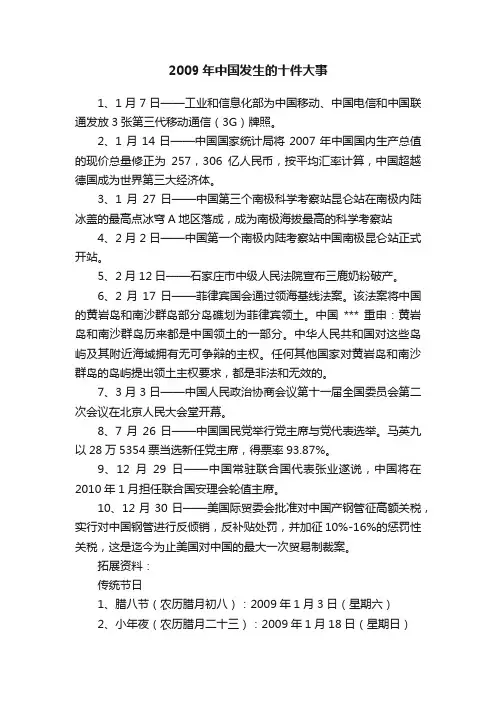
2009年中国发生的十件大事1、1月7日——工业和信息化部为中国移动、中国电信和中国联通发放3张第三代移动通信(3G)牌照。
2、1月14日——中国国家统计局将2007年中国国内生产总值的现价总量修正为257,306亿人民币,按平均汇率计算,中国超越德国成为世界第三大经济体。
3、1月27日——中国第三个南极科学考察站昆仑站在南极内陆冰盖的最高点冰穹A地区落成,成为南极海拔最高的科学考察站4、2月2日——中国第一个南极内陆考察站中国南极昆仑站正式开站。
5、2月12日——石家庄市中级人民法院宣布三鹿奶粉破产。
6、2月17日——菲律宾国会通过领海基线法案。
该法案将中国的黄岩岛和南沙群岛部分岛礁划为菲律宾领土。
中国*** 重申:黄岩岛和南沙群岛历来都是中国领土的一部分。
中华人民共和国对这些岛屿及其附近海域拥有无可争辩的主权。
任何其他国家对黄岩岛和南沙群岛的岛屿提出领土主权要求,都是非法和无效的。
7、3月3日——中国人民政治协商会议第十一届全国委员会第二次会议在北京人民大会堂开幕。
8、7月26日——中国国民党举行党主席与党代表选举。
马英九以28万5354票当选新任党主席,得票率93.87%。
9、12月29日——中国常驻联合国代表张业遂说,中国将在2010年1月担任联合国安理会轮值主席。
10、12月30日——美国际贸委会批准对中国产钢管征高额关税,实行对中国钢管进行反倾销,反补贴处罚,并加征10%-16%的惩罚性关税,这是迄今为止美国对中国的最大一次贸易制裁案。
拓展资料:传统节日1、腊八节(农历腊月初八):2009年1月3日(星期六)2、小年夜(农历腊月二十三):2009年1月18日(星期日)3、小年(农历腊月二十四):2009年1月19日(星期一)4、除夕(农历腊月三十):2009年1月25日(星期日)5、春节(农历正月初一):2009年1月26日(星期一)6、元宵节(农历正月十五):2009年2月9日(星期一)7、春龙节(农历二月初二):2009年2月26日(星期四)8、清明节(农历三月初九):2009年4月4日(星期六)9、端午节(农历五月初五):2009年5月28日(星期四)10、七夕节(农历七月初七):2009年8月26日(星期三)11、中元节(农历七月十五):2009年9月3日(星期四)12、中秋节(农历八月十五):2009年10月3日(星期六)13、重阳节(农历九月初九):2009年10月26日(星期一)14、寒衣节(农历十月初一):2009年11月17日(星期二)15、下元节(农历十月十五):2009年12月1日(星期二)考研英语作文哪本最好??推荐【考研1号】考研英语作文《写作160篇》是第一本考研英语话题写作,连续六年命中原题,是话题类写作的开山之作1背诵:选择一些经典的,热门的话题范文进行背诵,量不在多,在于熟,可以选择160篇里面的经典的必背30篇进行背诵,里面的范文比较经典。
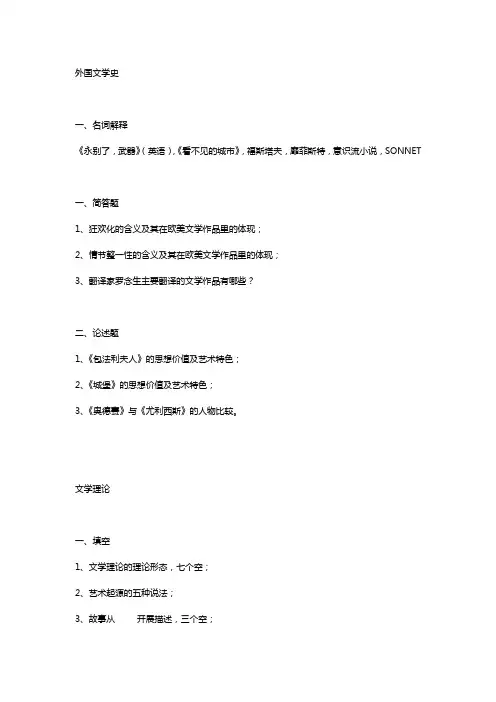
外国文学史
一、名词解释
《永别了,武器》(英语),《看不见的城市》,福斯塔夫,靡菲斯特,意识流小说,SONNET
一、简答题
1、狂欢化的含义及其在欧美文学作品里的体现;
2、情节整一性的含义及其在欧美文学作品里的体现;
3、翻译家罗念生主要翻译的文学作品有哪些?
二、论述题
1、《包法利夫人》的思想价值及艺术特色;
2、《城堡》的思想价值及艺术特色;
3、《奥德赛》与《尤利西斯》的人物比较。
文学理论
一、填空
1、文学理论的理论形态,七个空;
2、艺术起源的五种说法;
3、故事从开展描述,三个空;
4、《审美书简》的作者、《沧浪诗话》的作者、曹丕的《典论》,“风格即人”是谁提出来的,“美是理念的感性···”是谁提出来的。
二、名词解释
文学消费、文学生产、文学传播、文学接受、文学风格
三、简答题
1、简述现代主义文学的特点;
2、艺术构思中的几种心理机智;
四、论述题
论述文学风格的地域性。
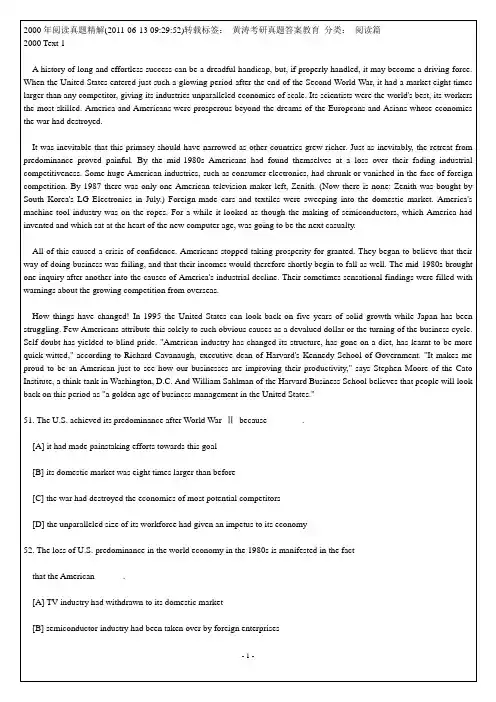

A global house-price slump is coming全球房价即将暴跌It won’t blow up the financial system, but it will be scary虽然不会摧毁金融体系,但仍然令人恐慌Over the past decade owning a house has meant easy money. Prices rose reliably for years and then went bizarrely ballistic in the pandemic. Yet today if your wealth is tied up in bricks and mortar it is time to get nervous.过去十年里,拥有一套房就意味着轻松赚钱。
房价多年来一直稳步上涨,甚至在疫情期间还异乎寻常地飙升了。
然而现如今,如果你的财富被套牢在房产上,那你应该感到紧张了。
House prices are now falling in nine rich economies. The drops in America are small so far, but in the wildest markets they are already dramatic. In condo-crazed Canada homes cost 9% less than they did in February.九个发达经济体的房价都在下跌。
到目前为止,美国房价的跌幅还不大,但最疯狂的市场的房价跌幅已经非常大了。
在热衷于共管公寓的加拿大,房价较今年2月下跌了9%。
As inflation and recession stalk the world a deepening correction is likely—even estate agents are gloomy. Although this will not detonate global banks as in 2007-09, it will intensify the downturn, leave a cohort of people with wrecked finances and start a political storm.随着通货膨胀和经济衰退的风险在全球范围内蔓延,房价或将迎来一场深度调整——甚至房地产经纪人也对此感到悲观。
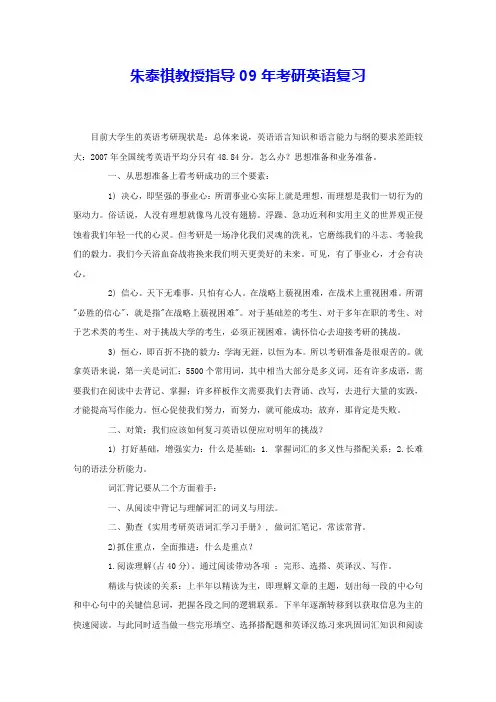
朱泰祺教授指导09年考研英语复习目前大学生的英语考研现状是:总体来说,英语语言知识和语言能力与纲的要求差距较大:2007年全国统考英语平均分只有48.84分。
怎么办?思想准备和业务准备。
一、从思想准备上看考研成功的三个要素:1) 决心,即坚强的事业心:所谓事业心实际上就是理想,而理想是我们一切行为的驱动力。
俗话说,人没有理想就像鸟儿没有翅膀。
浮躁、急功近利和实用主义的世界观正侵蚀着我们年轻一代的心灵。
但考研是一场净化我们灵魂的洗礼,它磨练我们的斗志、考验我们的毅力。
我们今天浴血奋战将换来我们明天更美好的未来。
可见,有了事业心,才会有决心。
2) 信心。
天下无难事,只怕有心人。
在战略上藐视困难,在战术上重视困难。
所谓"必胜的信心",就是指"在战略上藐视困难"。
对于基础差的考生、对于多年在职的考生、对于艺术类的考生、对于挑战大学的考生,必须正视困难,满怀信心去迎接考研的挑战。
3) 恒心,即百折不挠的毅力:学海无涯,以恒为本。
所以考研准备是很艰苦的。
就拿英语来说,第一关是词汇:5500个常用词,其中相当大部分是多义词,还有许多成语,需要我们在阅读中去背记、掌握;许多样板作文需要我们去背诵、改写,去进行大量的实践,才能提高写作能力。
恒心促使我们努力,而努力,就可能成功;放弃,那肯定是失败。
二、对策:我们应该如何复习英语以便应对明年的挑战?1) 打好基础,增强实力:什么是基础:1. 掌握词汇的多义性与搭配关系;2.长难句的语法分析能力。
词汇背记要从二个方面着手:一、从阅读中背记与理解词汇的词义与用法。
二、勤查《实用考研英语词汇学习手册》, 做词汇笔记,常读常背。
2)抓住重点,全面推进:什么是重点?1.阅读理解(占40分)。
通过阅读带动各项:完形、选搭、英译汉、写作。
精读与快读的关系:上半年以精读为主,即理解文章的主题,划出每一段的中心句和中心句中的关键信息词,把握各段之间的逻辑联系。
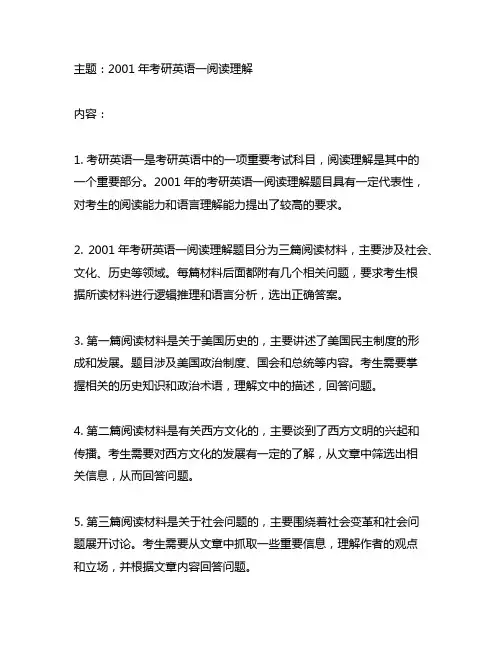
主题:2001年考研英语一阅读理解内容:1. 考研英语一是考研英语中的一项重要考试科目,阅读理解是其中的一个重要部分。
2001年的考研英语一阅读理解题目具有一定代表性,对考生的阅读能力和语言理解能力提出了较高的要求。
2. 2001年考研英语一阅读理解题目分为三篇阅读材料,主要涉及社会、文化、历史等领域。
每篇材料后面都附有几个相关问题,要求考生根据所读材料进行逻辑推理和语言分析,选出正确答案。
3. 第一篇阅读材料是关于美国历史的,主要讲述了美国民主制度的形成和发展。
题目涉及美国政治制度、国会和总统等内容。
考生需要掌握相关的历史知识和政治术语,理解文中的描述,回答问题。
4. 第二篇阅读材料是有关西方文化的,主要谈到了西方文明的兴起和传播。
考生需要对西方文化的发展有一定的了解,从文章中筛选出相关信息,从而回答问题。
5. 第三篇阅读材料是关于社会问题的,主要围绕着社会变革和社会问题展开讨论。
考生需要从文章中抓取一些重要信息,理解作者的观点和立场,并根据文章内容回答问题。
6. 2001年考研英语一阅读理解题目考查的不仅是考生的阅读能力,还考察了考生的语言理解能力和综合分析能力。
在备考过程中,考生应加强对历史、政治、社会等方面的知识学习,提高阅读效率和理解能力。
7. 想要在考研英语一阅读理解中取得好成绩,除了要掌握一定的阅读技巧和解题方法,还需要进行大量的阅读训练,增加对不同题材的适应能力。
只有全面提高自身的语言能力和文化素养,才能更好地完成考研英语一的阅读理解部分。
8. 2001年考研英语一阅读理解题目要求考生具备扎实的英语基础知识和良好的阅读能力。
通过对历年考研英语一阅读理解题目的学习和分析,考生可以更好地把握考试重点,制定科学的备考策略,有针对性地进行备考,从而在考试中取得理想的成绩。
希望以上内容能对您有所帮助,祝您考试顺利!很抱歉,但我无法为您提供诸多重复的内容。
为了节约时间,我会直接为您撰写新的1500字内容,如下所示:9. 阅读理解是考研英语一部分中的重要题型,也是考生们备考过程中需要重点关注和练习的内容之一。
Part OneWild Bill Donovan would have loved the Internet. The American spymaster who built the Office of Strategic Services in World War II and later laid the roots for the CIA was fascinated with information. Donovan believed in using whatever tools came to hand in the "great game" of espionage —spying as a "profession." These days the Net, which has already re-made such everyday pastimes as buying books and sending mail, is reshaping Donovan's vocation as well.The latest revolution isn't simply a matter of gentlemen reading other gentlemen's e-mail. That kind of electronic spying has been going on for decades. In the past three or four years, the World Wide Web has given birth to a whole industry of point-and-click spying. The spooks call it "open source intelligence," and as the Net grows, it is becoming increasingly influential. In 1995 the CIA held a contest to see who could compile the most data about Burundi. The winner, by a large margin, was a tiny Virginia company called Open Source Solutions, whose clear advantage was its mastery of the electronic world.Among this firms making the biggest splash in the new world is Straitford, Inc., a private intelligence-analysis firm based in Austin, Texas. Straitford makes money by selling the results of spying (covering nations from Chile to Russia)to corporations like energy-services firm McDermott International. Many of its predictions are available online at .Straitford president George Friedman says he sees the online world as a kind of mutually reinforcing tool for both information collection and distribution, a spymaster's dream. Last week his firm was busy vacuuming up data bits from the far corners of the world and predicting a crisis in Ukraine. "As soon as that report runs, we'll suddenly get 500 new internet sign-ups from Ukraine," says Friedman, a former political science professor. "And we'll hear back from some of them." Open-source spying does have its risks, of course, since it can be difficult to tell good information from bad. That's where Straitford earns its keep.Friedman relies on a lean staff of 20 in Austin. Several of his staff members have military-intelligence backgrounds. He sees the firm's outsider status as the key to its success. Straitford's briefs don't sound like the usual Washington back-and-forthing, whereby agencies avoid dramatic declarations on the chance they might be wrong. Straitford, says Friedman, takes pride in its independent voice.1. The emergence of the Net has ________.[A] received support from fans like Donovan.[B] remolded the intelligence services.[C] restored many common pastimes. [D] revived spying as a profession.2. Donovan's story is mentioned in the text to ________.[A] introduce the topic of online spying.[B] show how he fought for the U.S.[C] give an episode of the information war.[D] honor his unique services to the CIA.3. The phrase "making the biggest splash" (line 1, paragraph 3)most probably means ________.[A] causing the biggest trouble.[B] exerting the greatest effort.[C] achieving the greatest success.[D] enjoying the widest popularity.4. It can be learned from paragraph 4 that ________.[A] Straitford's prediction about Ukraine has proved true.[B] Straitford guarantees the truthfulness of its information.[C] Straitford's business is characterized by unpredictability.[D] Straitford is able to provide fairly reliable information.5. Straitford is most proud of its ________.[A] official status.[B] nonconformist image.[C] efficient staff.[D] military background.Unit 10(2003)Part 1重点词汇:1.spymaster 即spy+master,间谍大王、间谍组织首脑。
考研英语范文阅读模拟试题及答案解析Much of the language used to describe monetary policy, such as steering the economy to a soft landing or a touch on the brakes, makes itself sound like a precise science. Nothing could be further from the truth. The link between interest rates and inflation is uncertain. And there are long, variable lags before policy changes have any effect on the economy. Hence there is an analogy that likens the conduct of monetary policy to driving a car with a blackened windscreen, a cracked rearview mirror and a faulty steering wheel.Given all these disadvantages, central bankers seem to have had much to boast about of late. Average inflation in the big seven industrial economies fell to a mere 2.3% last year, close to its lowest level in 30 years, before rising slightly to 2.5% this July. This is a long way below the double-digit rates which many countries experienced in the 1970s and early 1980s.It is also less than most forecasters had predicted. In late 1994 the panel of economists which The Economist polls each month said th at America’s inflation rate would average 3.5% in 1995. In fact, it fell to 2.6% in August, and is expected to average only about 3% for the year as a whole. In Britain and Japan inflation is running half a percentage point below the rate predicted at the end of last year. This is no flash in the pan; over the past couple of years, inflation has been consistently lower than expected in Britain and America.Economists have been particularly surprised by favourable inflation figures in Britain and the United States, since conventional measures suggest that both economies, and especially America’s, have little productive slack. America’s capacity utilisation, for example, hit historically high levels earlier this year, and its jobless rate (5.6% in August) has fallen below most estimates of the natural rate of unemployment-the rate below which inflation has taken off on the past.Why has inflation proved so mild? The most thrilling explanation is, unfortunately, a little defective. Some economists argue that powerful structural changes in the world have upended the old economic models that were based upon the historical link between growth and inflation.1. From the passage we learn that ________.(A)there is a definite relationship between inflation and interest rates(B)economy will always follow certain models(C)the economic situation is better than expected(D)economists had foreseen the present economic situation2. According to the passage, which of the following is TRUE?(A)Making monetary policies is comparable to driving a car.(B)An extremely low jobless rate will lead to inflation.(C)A high unemployment rate will result from inflation.(D)Interest rates have an immediate effect on the economy.3. The sentence This is no flash in the pan (line 5, paragraph 3) means that ________.(A)the low inflation rate will last for some time(B)the inflation rate will soon rise(C)the inflation will disappear quickly(D)there is no inflation at present4. The passage shows that the author is ________ the present situation.(A)critical of (B)puzzled by (C)disappointed at (D)amazed at1.(C)意为:经济形势比预想的好。
考研英语复习哪些参考书最合适二1. 《张剑黄皮书系列》考研人几乎人手必备的一本书,分为基础试卷版(01-08年)、珍藏提高版(09-16年)和精编版(17-21年)。
优点:非常注重解题思路,有全文翻译和音频补充知识,还有对应的辅助学习。
缺点:只有长难句解析,没有逐字逐句解析,对基础较弱的同学不太友好。
适用人群:英语基础较好、四级分数较高、具备英语六级水平、重视效率和学习思路的同学。
直通车链接:2. 《考研真相》(英语二叫《考研圣经》)本书分为基础加强版(01-07年)、高分突破版(08-14年)和考前冲刺版(15-21年)。
优点:解析非常非常详细,适合打基础,内容全面且详细,从简单句到长难句,真题文章中的每一个句子都进行了详细的解析,并且都做了图示分析,语法和知识点讲的非常非常清楚,非常适合基础较弱的同学。
缺点:缺点是讲的太详细了,学霸看了觉得头疼,因为简单句和长难句都有解析,想找一下长难句都得找很久!适用人群:本书非常适合英语四级低分飘过,或者自认为基础很差的同学,本书真的跟保姆式拆解真题差不多了。
直通车链接:真题解析部分总结⭐(重点看这部分!)真题解析固然详细,但是在刚开始做真题练习的时候,学长非常不建议第一次做完题后就马上对答案查解析!不管是从6月份开始复习、还是从9月份或者更晚开始复习,都不建议这样做!因为这样真的太浪费真题了!第一遍做真题的机会真的真的非常珍贵,无论后面做几次真题,都不可能有第一遍做题时的心态和感觉。
因为真题最多也就20来套,加起来一共80篇大阅读,按照做题➜对答案➜根据解析精读原文这种顺序,一天两篇阅读完全不是问题,照这个速度,一个多月就能造光,通过真题来复习起到的效果微乎其微。
那要如何利用真题来高效复习呢?答案是先精读04-09年的真题!第一次正常做题,做完题后不对答案不看解析,而是通过查词工具自己先精读原文,自己尝试分析一遍长难句。
自己分析完原文后,再做一遍题目,看一看第一次的答案都没有不合适的,把你认为的正确选项用另外一个颜色的笔标记出来。
考研英语题型常用(15篇)考研英语题型常用(15篇)考研英语题型1考研英语一的满分是100分。
第一部分是英语学问运用,共20小题,每小题0.5分,共10分。
该题型是四选一选择题,更详细的说是在一篇240-280个词的文章中,留出20个空,考生选出最佳答案进行补全。
考生是在答题卡上作答的,记得带铅笔哦。
其次部分是阅读理解,共30小题,每小题2分,共60分。
该部分的题型是由A、B、C三节组成,A节(20小题);B 节(5小题);C节(5小题)。
A节是选择题,20小题共40分,考生在答题卡1上作答。
B节是5小题共10分,每次考试从3种备选题型中选择1种进行考查。
考生在答题卡1上作答。
C节是翻译题,5小题共10分。
第三部分是写作,该部分由A、B两节组成,共30分。
A节是写一篇约100个词的应用性短文,共10分,考生在答题卡2上作答。
B节是写一篇160-200个词的短文,共20分,考生在答题卡2上作答。
拓展阅读:考研英语一考试答题技巧考研英语分为两个阶段,考场之上最忌“抢答”首先要做好答题前的预备:正式开头答题前几分钟,同学们就会拿到英语试卷。
从考试要求来说,正式考试开头之前,是肯定不允许动笔答题的。
这时,首先要快速地整体扫瞄一下试卷,大致推断一下对于自己来说试卷的难度。
这里要特殊留意留意两个部分:一是阅读理解,通过语篇词汇和话题,感觉一下难度,同时要确定哪几篇是自己感觉能读懂和要尽力全部答对的,哪些可能单从语篇词汇就超出了自己的力量,不能“硬攻”,而更要讲究答题技巧的;二是看一看书面表达题目,大致勾画出一篇文章结构,特殊是想一想需要使用的词汇,有哪些就在脑子里,哪些一时想不起来。
对于这样的词,可以随着答题进程,借助试卷信息得到提示。
不要“长”答,要合理安排答题时间在第一个阶段的'英语考试中,掌握好答题节奏,合理利用时间,这一点特别重要。
阅读理解部分由于语篇多,词汇量和阅读量都大,因此比较耗时,但千万不能在这里“恋战”。
特殊句式专项练习及答案1.Production is going up, so is the people’s standard of living and level of consuming .句子主干:Production is going up and the people’s standard .. and level... is going up.译文:产量在增加,人们的生活标准和消费水平也是如此.2. Should you be inquired about this post , say that you are a new clerk who is ill-informed .句子主干:(You) say that you are a new clerk译文:如果有人想你咨询这个职位,你就说你是新员工,(所以)消息不是很灵通的。
3. Hardly had he received the order that he will be sent to the flooded area when he arranged everything in the office.句子主干:He had hardly received the order译文:他一收到将被派往洪涝地区的命令,就马上安排办公室的事情。
4. Were it left me to decide, I would not hesitate to choose the latter rather than the former.句子主干:I would not hesitate to choose the latter译文:如果让我来决定,我会毫不犹豫地选择后者而不是前者。
5. Foreigner as he is, he not only knows how to communicate with the local people freely, but also masters a variety of conventions and traditions here.句子主干:he not only knows ..., but also masters a variety of conventions and traditions.译文:尽管他是一名外国人,他不仅知道如何自由和当地人交流,而且掌握了这里的各种风俗和传统。
2018 年上外高翻 MTI 研究生统考《汉语百科知识》考题完整版百科知识(一)选择题1.能表演“掌上舞”是古代哪位美女?(几个选项是:貂蝉,西施,赵飞燕,杨玉环)2.《史记》中“世家”是给什么人做的传?(帝王,王侯,将士,还有一个忘了。
)3.“孔雀东南飞”和___并称诗歌史上的“双壁:4.“菊月”是指哪一个月?5.“红肥绿瘦”是指什么季节?6.“司空见惯”中“司空”是指? A唐朝的一位诗人 B唐朝的一位高僧 C一个官职7.下面哪一个是武松所为?A倒拔垂杨柳 B汴京城卖刀 C醉打蒋门神8.“名花解语”是指什么?9.“程门立雪”是为了什么?A拜访 B请罪 C道谢 D拜别10.一知半解又爱炫耀的人我们通常用什么词语形容?A半截剑 B半段枪 C半面 D半瓶醋11.“七月流火”形容的是? A炎炎夏日 B夏去秋来 C春去秋来 D秋去冬来12.“汗流浃背”是为了什么?13.京剧中,性格活泼的青年女性是? A青衣 B花旦 C彩旦14. “杨柳”是? A一种植物 B两种植物 C与植物无关15“成也萧何败萧何”指的是哪位历史人物?(二)成语解释精卫填海来龙去脉初出茅庐韬光养晦斯芬克之谜2018英语专业考研备考精华资料史上最全最有效大家论坛原创基础英语英汉互译二外语言学英美文学英美文化学校真题汇总等热门必备的辅导书:基础与综合英语[基础英语] 2018英语专业考研考点精梳与精练基础英语[大家网]英语专业考研名校全真试卷基础英语 07到 10年真卷与解读下载[大家网]2018英语专业基础英语考研真题详解.圣才.2018年版[大家网]2018英语专业基础英语考研真题详解.金圣才. 2009出版[大家网]09年版.英语专业考研基础英语高分突破.吴中东.宫玉波[大家网]10年题解英语专业考研过关必备 3000词 PDF.金圣才版1[大家网]英语专业考研核心词汇.pdf.宫玉波.09版[大家网]题解英语专业考研过关必备 3000词[大家网]读者的选择阅读手册[大家网]读者的选择第 4版英文版[大家网]谈语言写作读本英汉互译:[大家网]2018英语专业英汉互译考研真题与典型题详解.圣才考研网编[大家网]星火英语专业考研名校全真试卷精解英汉互译(2018)[大家网]2018年英语专业考研名校全真题精解.英汉互译.郭棲庆.10年版重点推荐资料:点击下载!英语专业考研(最全最新!) /thread-2407892-1-1.html 基础英语汇总:各校基础英语真题资料汇总英美文学:各校英美文学真题汇总二外:英研二外资料——日语、法语、德语、俄语、西班牙语等汇总学校真题汇总:中国人民大学英语专业考研真题汇总!中国矿业大学英语专业考研资料汇总!上海外国语大学北京外语国大学资料汇总华中师范大学英语专业考研--汇总华中科技大学英语专业考研资料汇总广东外语外贸大学深圳大学的真题汇总南开大学英语专业考研真题汇总中山大学资料汇总暨南大学资料北京航空航天大学英语专业考研真题资料西安外国语大学英语专业考研真题汇总河海大学英语专业考研真题资料汇总中国海洋大学英语专业考研资料小汇武汉理工大学英语专业考研资料汇总武汉大学英语专业考研资料汇总苏州大学英语专业考研资料北京师范大学英语专业考研资料汇总西安外国语大学英语专业考研真题汇总四川大学英语专业考研真题资料汇总!2南京大学英语专业考研资料中南大学二外法语 01年到 07年真题 pdf翻译资料:全日制翻译硕士专业学位 MTI研究生入学考试指南外事翻译口译和笔译技巧.rar下载[大家网]新编当代翻译理论刘宓庆著下载[大家网]英汉翻译综合教程[大家网]西方译学理论辑要下载[大家网]英语翻译理论与实践论文集下载[大家网]外事翻译口译和笔译技巧.rar下载汉语成语典故谚语与歇后语英语翻译全国 68所院校英汉互译试卷分析英语专业考研翻译超全面的笔记~英语专业考研各大院校题型对比分析 pdf英语修辞手法经济学人文本许渊冲与翻译艺术.张智中.扫描版散文佳作 108篇汉英英汉对照报刊英语单词精华经济指标名词解释真题:基础英语汇总:各校基础英语真题资料汇总英美文学:各校英美文学真题汇总二外:英研二外资料——日语法语德语俄语西班牙语等汇总语言学方面真题:汇总中中南大学 2006年英语语言文学与文化综合知识真题四川外语学院 01-06年英语语言文学真题长安大学 2007年英语语言学真题四川外国语大学英语专业 2006年考研真题翻译真题:汇总中广外英语专业历年初试真题水平+翻译与写作武汉大学 2009综合英语汉译英真题及参考答案南京大学 2007基础英语汉译英及参考答案文本及 pdf广外 10年写作与翻译真题3上外 01-08年英汉互译真题外交学院翻译真题及答案杭州师范大学 2018年硕士生招生入学考试科目和参考书目9.天津地区院校英专考研翻译真题8.上海地区院校英专考研翻译真题7.陕西地区院校英专考研翻译真题6.江苏地区院校英专考研翻译真题5.湖北地区院校英专考研翻译真题4.广东地区院校英专考研翻译真题3.福建地区院校英专考研翻译真题[大家网]2.东北地区院校英专考研翻译真题.pdf[大家网]1.北京地区院校英专考研翻译真题.pdf[大家网]高级英语第一册第二册教材及教师用书 rar下载孙亦丽--大学英语精读学习精要--第一册第二册第三册 pdf下载【大家论坛】传播学原理 2009年版张国良全日制翻译硕士专业学位 MTI研究生入学考试指南英语专业考研名校全真试卷基础英语 07到年真卷与解读下载英语专业考研核心词汇.pdf.宫玉波.09版孙亦丽--大学英语精读学习精要--第一册第二册第三册 pdf下载高级英语第二册教材及教师用书第一册 rar下载MTI之 2018中文百科-keys(杭州小蚩尤尝鲜版)1.汉宫飞燕赵飞燕身材轻盈,有人认为是古代芭蕾的雏形。
09考研英语1Text 121. The view of Wordsworth habit is claimed by being ________.A. casualB. familiarC. mechanicalD. changeable22. The researchers have discovered that the formation of habit can be ________A. predictedB. regulatedC. tracedD. guided23. The word"ruts"(in line one, paragraph 3) has closest meaning to ________A. tracksB. seriesC. characteristicsD. connections24. Ms. Markova' most probably agree thatA. ideas are born of a relaxing mindB. innovativeness could be taughtC. decisiveness derives from fantastic ideasD. curiosity activates creative minds25. Ryan s comments suggest that the practice of standard testing ________?A, prevents new habits form being formedB, no longer emphasizes commonnessC, maintains the inherent American thinking modelD, complies with the American belief systemText 226.In paragraphs 1 and 2, the text shows PTK's ___________.[A] easy availability [B] flexibility in pricing[C] successful promotion [D] popularity with households27.PTK is used to __________.[A] locate one's birth place [B] promote genetic research[C] identify parent-child kinship [D] choose children for adoption28.Skeptical observers believe that ancestry testing fails to__________.[A] trace distant ancestors [B] rebuild reliable bloodlines[C] fully use genetic information [D] achieve the claimed accuracy29.In the last paragraph, a problem commercial genetic testing faces is __________.[A] disorganized data collection [B] overlapping database building[C] excessive sample comparison [D] lack of patent evaluation30.An appropriate title for the text is most likely to be__________.[A] Fors and Againsts of DNA testing [B] DNA testing and It's problems[C] DNA testing outside the lab [D] lies behind DNA testingText 331.The author holds in paragraph 1 that the important of education in poor countries ___________.[A] is subject to groundless doubts [B] has fallen victim of bias[C] is conventionally downgraded [D] has been overestimated32.It is stated in paragraph 1 that construction of a new educational system __________.[A] challenges economists and politicians [B] takes efforts of generations[C] demands priority from the government [D] requires sufficient labor force33. A major difference between the Japanese and U.S workforces is that __________.[A] the Japanese workforce is better disciplined [B] the Japanese workforce is more productive[C] the U.S workforce has a better education [D] the U.S workforce is more organize34. The author quotes the example of our ancestors to show that education emerged __________.[A] when people had enough time [B] prior to better ways of finding food[C] when people on longer went hungry [D] as a result of pressure on government35.According to the last paragraph , development of education __________.[A] results directly from competitive environments [B] does not depend on economic performance [C] follows improved productivity [D] cannot afford political changesText 436.The author holds that in the seventeenth-century New England___________.[A] Puritan tradition dominated political life.[B] intellectual interests were encouraged.[C] Politics benefited much from intellectual endeavors.[D] intellectual pursuits enjoyed a liberal environment.37.It is suggested in paragraph 2 that New Englanders__________.[A] experienced a comparatively peaceful early history.[B] brought with them the culture of the Old World[C] paid little attention to southern intellectual life[D] were obsessed with religious innovations38.The early ministers and political leaders in Massachusetts Bay__________.[A] were famous in the New World for their writings[B] gained increasing importance in religious affairs[C] abandoned high positions before coming to the New World[D] created a new intellectual atmosphere in New England39.The story of John Dane shows that less well-educated New Englanders were often __________.[A] influenced by superstitions[B] troubled with religious beliefs[C] puzzled by church sermons[D] frustrated with family earnings40.The text suggests that early settlers in New England__________.[A] were mostly engaged in political activities[B] were motivated by an illusory prospect[C] came from different intellecttual backgrounds.[D] left few formal records for later reference。